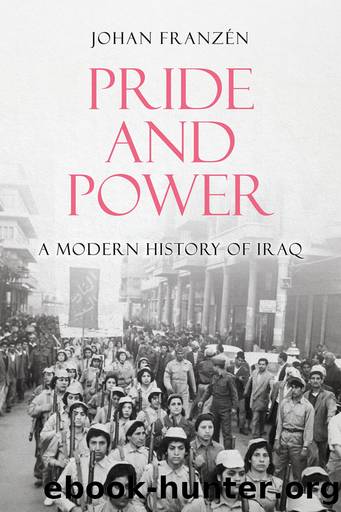Pride and Power by Johan Franzén

Author:Johan Franzén
Language: eng
Format: epub
Publisher: Oxford University Press
Published: 2021-05-14T16:00:00+00:00
Human Waves, Cannon Fodder, and Attrition
Iraqâs military strategy, insofar as one could be discerned, was to quickly seizeâor âliberateââthe province of Khuzestan. The first step was to capture the old Arab emirate of Muhammarah, which the Iranians had renamed Khorramshahr, and then to take over Ahvaz. Far from the swift military victory Saddam had envisaged, however, the move proved more difficult than expected as the Iranian army offered stiff resistance. A siege was laid to Khorramshahr whilst hundreds of Soviet T-55 tanks pressed up the road to Ahvaz. An Iraqi communiqué announced on 27 September that Ahvaz had fallen to the Iraqi onslaught. That was a ruse; 3 days later the Iraqis were still stuck in trenches 14 miles south of the city, being pounded by Iranian artillery and bombardment from Phantom planes.45 Meanwhile, Iraqi troops were locked in âhand-to-handâ combat in Khorramshahr.46 The Iranians successfully managed to drop paratroopers into the city, further stiffenening the resistance, whilst artillery kept pounding the besieging forces. On radio, President Bani-Sadr called on Khorramshahrâs inhabitants to turn its gates into a âslaughter place for all Iraqi invadersâ whilst ordering a âgeneral mobilisationâ of the entire population of Khuzestan and urging them to ârise up and take part in a heroic battleâ to protect their âhonor and religionâ.47 Despite the reinforcement Khorramshahr fell a few days later. Yet, Abadan, to the south of Khorramshar on the Shatt al-á¶Arab, was still resisting the Iraqi siege, as was Ahvaz.48
Both sides were now carrying out airstrikes against military, economic, and civilian targets. Iraq targeted in particular Iranian oil installations around Abadan, whilst the Iranians retaliated by taking out Iraqi shipping facilities and targeting Iraqâs nuclear development site. Unexpected Iranian prowess in the air may explain why direct aerial engagements largely were avoided by Iraq. The Chief of Staff of the US Airforce General Lew Allen Jr. said the Americans were surprised at the âeffectivenessâ shown by the Iranian air force and perplexed as to why the Iraqis had been so ârestrainedâ in their approach, refusing as much as possible to take part in air-to-air combat.49 This development, commented Richard Burt in the New York Times, could be indicative of âa new type of war in the third world in which ever more destructive military power is applied in an erratic and unrestrained mannerâ, adding that the fighting between Iran and Iraq with its âspectacular air strikes against civilian targetsâ had been very different from typical Third World conflicts which normally only involved limited border warfare.50 By seriously miscalculating Iranâs ability to resist an invasion, noted Eric Davis, Iraq had âset in motion forces that will damage or seriously retard Iraqâs own economic and political development.â51
Despite the use of highly mobile tank units, Iraq was unable to replicate the German Blitzkrieg of World War IIâmainly because it could not provide sufficient air cover for the operation. The invasion soon stalled. Khorramshahr had fallen, but Ahvaz remained resilient even after weeks of siege. More and more resources were put
Download
This site does not store any files on its server. We only index and link to content provided by other sites. Please contact the content providers to delete copyright contents if any and email us, we'll remove relevant links or contents immediately.
The Vikings: Conquering England, France, and Ireland by Wernick Robert(77296)
Ali Pasha, Lion of Ioannina by Eugenia Russell & Eugenia Russell(39319)
The Vikings: Discoverers of a New World by Wernick Robert(36481)
Cecilia; Or, Memoirs of an Heiress — Volume 1 by Fanny Burney(31332)
Cecilia; Or, Memoirs of an Heiress — Volume 3 by Fanny Burney(30934)
Cecilia; Or, Memoirs of an Heiress — Volume 2 by Fanny Burney(30889)
The Conquerors (The Winning of America Series Book 3) by Eckert Allan W(27642)
Empire of the Sikhs by Patwant Singh(22171)
The Secret History by Donna Tartt(16621)
Hans Sturm: A Soldier's Odyssey on the Eastern Front by Gordon Williamson(16618)
Cat's cradle by Kurt Vonnegut(13866)
Sapiens: A Brief History of Humankind by Yuval Noah Harari(13050)
Pimp by Iceberg Slim(12931)
Leonardo da Vinci by Walter Isaacson(11901)
Norse Mythology by Gaiman Neil(11882)
Talking to Strangers by Malcolm Gladwell(11875)
Underground: A Human History of the Worlds Beneath Our Feet by Will Hunt(11256)
4 3 2 1: A Novel by Paul Auster(11046)
The Radium Girls by Kate Moore(10907)
